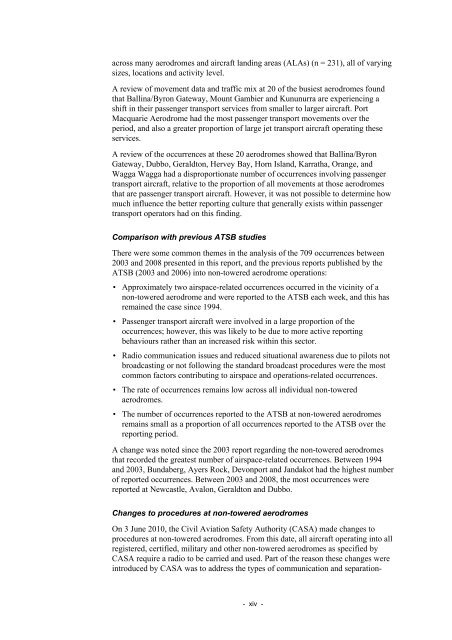Safety in the vicinity of non-towered aerodromes - Australian ...
Safety in the vicinity of non-towered aerodromes - Australian ...
Safety in the vicinity of non-towered aerodromes - Australian ...
Create successful ePaper yourself
Turn your PDF publications into a flip-book with our unique Google optimized e-Paper software.
across many <strong>aerodromes</strong> and aircraft land<strong>in</strong>g areas (ALAs) (n = 231), all <strong>of</strong> vary<strong>in</strong>g<br />
sizes, locations and activity level.<br />
A review <strong>of</strong> movement data and traffic mix at 20 <strong>of</strong> <strong>the</strong> busiest <strong>aerodromes</strong> found<br />
that Ball<strong>in</strong>a/Byron Gateway, Mount Gambier and Kununurra are experienc<strong>in</strong>g a<br />
shift <strong>in</strong> <strong>the</strong>ir passenger transport services from smaller to larger aircraft. Port<br />
Macquarie Aerodrome had <strong>the</strong> most passenger transport movements over <strong>the</strong><br />
period, and also a greater proportion <strong>of</strong> large jet transport aircraft operat<strong>in</strong>g <strong>the</strong>se<br />
services.<br />
A review <strong>of</strong> <strong>the</strong> occurrences at <strong>the</strong>se 20 <strong>aerodromes</strong> showed that Ball<strong>in</strong>a/Byron<br />
Gateway, Dubbo, Geraldton, Hervey Bay, Horn Island, Karratha, Orange, and<br />
Wagga Wagga had a disproportionate number <strong>of</strong> occurrences <strong>in</strong>volv<strong>in</strong>g passenger<br />
transport aircraft, relative to <strong>the</strong> proportion <strong>of</strong> all movements at those <strong>aerodromes</strong><br />
that are passenger transport aircraft. However, it was not possible to determ<strong>in</strong>e how<br />
much <strong>in</strong>fluence <strong>the</strong> better report<strong>in</strong>g culture that generally exists with<strong>in</strong> passenger<br />
transport operators had on this f<strong>in</strong>d<strong>in</strong>g.<br />
Comparison with previous ATSB studies<br />
There were some common <strong>the</strong>mes <strong>in</strong> <strong>the</strong> analysis <strong>of</strong> <strong>the</strong> 709 occurrences between<br />
2003 and 2008 presented <strong>in</strong> this report, and <strong>the</strong> previous reports published by <strong>the</strong><br />
ATSB (2003 and 2006) <strong>in</strong>to <strong>non</strong>-<strong>towered</strong> aerodrome operations:<br />
• Approximately two airspace-related occurrences occurred <strong>in</strong> <strong>the</strong> vic<strong>in</strong>ity <strong>of</strong> a<br />
<strong>non</strong>-<strong>towered</strong> aerodrome and were reported to <strong>the</strong> ATSB each week, and this has<br />
rema<strong>in</strong>ed <strong>the</strong> case s<strong>in</strong>ce 1994.<br />
• Passenger transport aircraft were <strong>in</strong>volved <strong>in</strong> a large proportion <strong>of</strong> <strong>the</strong><br />
occurrences; however, this was likely to be due to more active report<strong>in</strong>g<br />
behaviours ra<strong>the</strong>r than an <strong>in</strong>creased risk with<strong>in</strong> this sector.<br />
• Radio communication issues and reduced situational awareness due to pilots not<br />
broadcast<strong>in</strong>g or not follow<strong>in</strong>g <strong>the</strong> standard broadcast procedures were <strong>the</strong> most<br />
common factors contribut<strong>in</strong>g to airspace and operations-related occurrences.<br />
• The rate <strong>of</strong> occurrences rema<strong>in</strong>s low across all <strong>in</strong>dividual <strong>non</strong>-<strong>towered</strong><br />
<strong>aerodromes</strong>.<br />
• The number <strong>of</strong> occurrences reported to <strong>the</strong> ATSB at <strong>non</strong>-<strong>towered</strong> <strong>aerodromes</strong><br />
rema<strong>in</strong>s small as a proportion <strong>of</strong> all occurrences reported to <strong>the</strong> ATSB over <strong>the</strong><br />
report<strong>in</strong>g period.<br />
A change was noted s<strong>in</strong>ce <strong>the</strong> 2003 report regard<strong>in</strong>g <strong>the</strong> <strong>non</strong>-<strong>towered</strong> <strong>aerodromes</strong><br />
that recorded <strong>the</strong> greatest number <strong>of</strong> airspace-related occurrences. Between 1994<br />
and 2003, Bundaberg, Ayers Rock, Devonport and Jandakot had <strong>the</strong> highest number<br />
<strong>of</strong> reported occurrences. Between 2003 and 2008, <strong>the</strong> most occurrences were<br />
reported at Newcastle, Avalon, Geraldton and Dubbo.<br />
Changes to procedures at <strong>non</strong>-<strong>towered</strong> <strong>aerodromes</strong><br />
On 3 June 2010, <strong>the</strong> Civil Aviation <strong>Safety</strong> Authority (CASA) made changes to<br />
procedures at <strong>non</strong>-<strong>towered</strong> <strong>aerodromes</strong>. From this date, all aircraft operat<strong>in</strong>g <strong>in</strong>to all<br />
registered, certified, military and o<strong>the</strong>r <strong>non</strong>-<strong>towered</strong> <strong>aerodromes</strong> as specified by<br />
CASA require a radio to be carried and used. Part <strong>of</strong> <strong>the</strong> reason <strong>the</strong>se changes were<br />
<strong>in</strong>troduced by CASA was to address <strong>the</strong> types <strong>of</strong> communication and separation-<br />
- xiv -
















